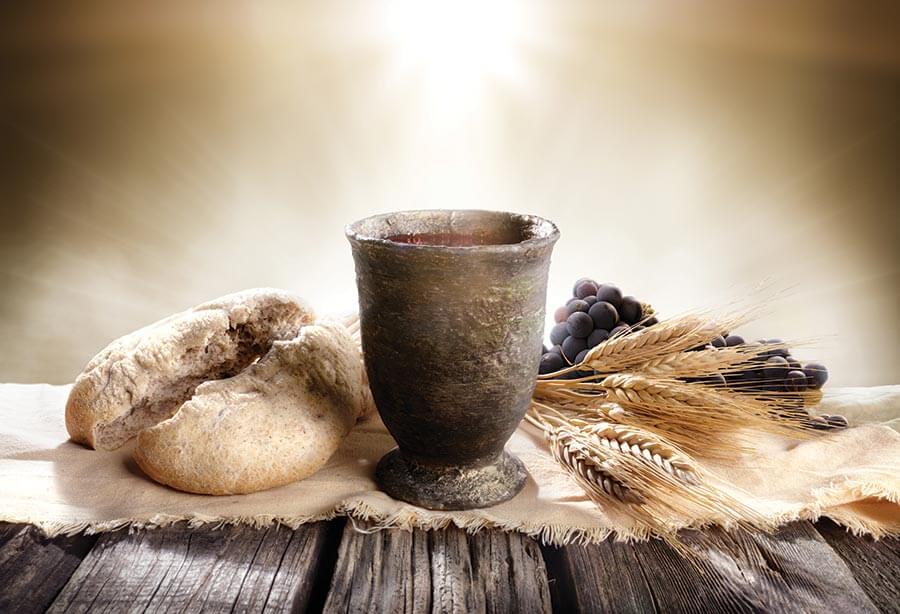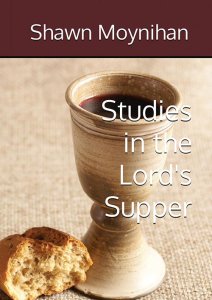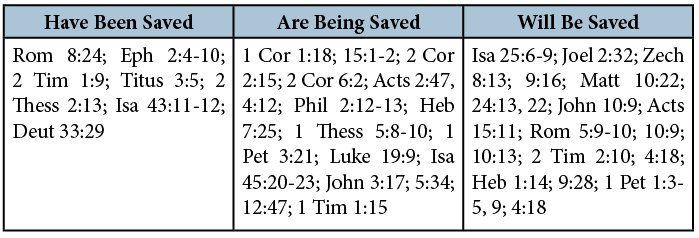“Studies In The Lord’s Supper”, by Shawn Moynihan
Have you ever really considered what Jesus was trying to help us accomplish when he instituted the Breaking of Bread all those years ago with his disciples? Is it the Last Supper? Or the First Supper?
 Read Time: 12 minutes
Read Time: 12 minutes
The Tidings is pleased to announce the publishing of a new book by Bro. Shawn Moynihan, Studies in the Lord’s Supper.
Bro. Shawn Moynihan’s book entitled, Studies in the Lord’s Supper takes us on a journey through the Bible, showing us just what Jesus was teaching and what it means for us. This event was very important to Jesus, and he was passionate about it.
Bro. Shawn provides us with a close look at the institution of this Passover feast with the apostles by examining the Passover that Moses initiated. He also supplies us with a good discussion about the timing of this meal.
He expounds on all the symbols of Christ’s body: the cup, the grapes, the bread and the peace offering used to celebrate our relationship with God and the fulfillment of that symbolism in Christ’s death and resurrection.
This book will provide you with a deeper relationship with God and His son
There is a full section dedicated to celebrating the night of “this passover” in the four gospels. Bro. Shawn displays how we can be so much closer to God and Christ when we participate with each other in this blessing—the necessity of preparation for it both physically and most importantly—spiritually.
He brings us back in time to the early ecclesias, looking at how they celebrated and discussed the issues that arose about the way some were performing it. He also brings us forward through the centuries, looking at the ways the ritual has changed. Finally, we are brought to the marriage supper of the Lamb, which we long for.
It is worth the read, and God willing will provide you with a deeper relationship with God and His son every time you engage in this most important part of our memorial service—sharing with our brothers and sisters around the world on a weekly basis—joyfully, reverentially with a deeper understanding of this precious gift which Jesus invited us to follow with his example of longing to eat it with all our heart.
Book Reviewed by:
Linda Beckerson,
Ann Arbor Ecclesia, MI
Following is chapter 19 of Bro. Shawn’s book, which we are providing here as a preview. We believe it gives the sense of how well-researched and insightful this new work is for our community. You may obtain your copy of the book through Amazon.com.
You can find the link to this book and many others on our website at: www.tidings.org/publications
Excerpt from “Studies in the Lord’s Supper“

SHOWING THE LORD’S DEATH
For as often as ye eat this bread, and drink this cup, ye do shew the Lord’s death till he come. (1 Cor 11:26).
Paul tells us that every time we participate in the Lord’s Supper, we “shew” (KJV) Christ’s death until he comes. Practically speaking, what does this mean for us when we participate in the Lord’s Supper?
By unpacking the component parts of the phrase “ye do shew the Lord’s death until he come,” we can deepen our understanding of these very familiar words.
Shew
Versions of the Bible usually render the word translated “shew” [katangellō] in the King James Version as either “proclaim” or “tell.” Katangellō literally means to “declare down” and has a strong sense of public sharing.
Vincent states that the word means “to proclaim with authority, as commissioned to spread the tidings throughout, down among those that hear them, with the included idea of celebrating or commending.”1
To attempt to capture the word’s meaning, some dynamic translations render katangellō as “you are announcing the Lord’s death until he comes again” (NIrV). Katangellō is used seventeen times in the New Testament.
It is usually translated as “preach” in the King James Version. Given the focus on preaching in Acts, it is no surprise that katangellō is used many times in this book (Acts 4:2; 13:5, 38; 15:36; 16:17, 21; 17:3, 13, 23; 26:23). Whether in the synagogue or on Mars Hill, katangellō was the public proclamation of the Gospel. In Philippians, Paul uses the word to capture all the ways that Christ is preached,
“What then? Only that in every way, whether in pretense or in truth, Christ is preached [katangellō]; and in this I rejoice, yes, and will rejoice” (1:18).
In terms of helping us understand 1 Corinthians 11:26, the most relevant occurrences are the two other times that Paul uses katangellō in 1 Corinthians:
And I, brethren, when I came to you, did not come with excellence of speech or of wisdom declaring [katangellō] to you the testimony of God. (1 Cor 2:1).
Even so the Lord has commanded that those who preach [katangellō] the gospel should live from the gospel. (1 Cor 9:14).
From the way that katangellō is used, both throughout the New Testament and in 1 Corinthians, we can confidently infer that Paul was using this word to describe an act of public preaching.
By taking up the Bread and the Cup, we are preaching about Christ’s death. Three key questions emerge from this inference: What is the content of the preaching message? How is the message delivered? Who is the audience for this preaching? The celebration of Passover helps us answer these questions.
By taking up the Bread and the Cup, we are preaching about Christ’s death.
Passover and the “Cup of Proclamation”
Passover was clearly on Paul’s mind as he was writing to the Corinthian ecclesia about the Lord’s Supper. As part of his discourse on the Lord’s Supper, Paul grounds the partaking in Passover, “The cup of blessing which we bless, is it not the communion of the blood of Christ?” (1 Cor 10:16). The “cup of blessing” was the third of the four Passover cups. Similarly, by describing the partaking of the Bread and Cup as a “proclamation,” Paul is referring to the second cup of Passover, the Maggid, called the “cup of proclamation.”
The second Passover cup was called the cup of proclamation because it was at this point that the person leading the Seder told the story of Israel’s deliverance from bondage in Egypt. Several commentators have noted the connection between katangellō and the Hebrew practice of Haggadah.
The Haggadah (literally, “the telling”) is the historical explanation of the events and meaning of Passover; the connection between Passover and the Lord’s Supper informed many translators’ decision to render katangellō as “tell,” In the table below, we also see the strong parallel between the command to “shew” the story of Passover and the command to “shew” Christ’s death, as embodied in the KJV’s translation of katangellō as “shew”:

This part of the Passover celebration was deliberately a teaching time, in fulfillment of God’s requirement that the story of deliverance be shared with the next generation of God’s family:
As the text indicates, the learning was not to be through passive hearing, but rather interactive participation marked by questions and answers.
We have a good understanding of what the content of the “proclamation” was like at the time of Christ. Rabbi Gamaliel (Paul’s teacher) commented extensively on this topic, and his commentary was preserved in the Mishnah.2 Gamaliel taught that the story must emphasize three things: the lamb, the unleavened bread, and the bitter herbs. He also stated that the “telling” should emphasize that participants must understand that God is saving them, just as He saved the children of Israel from slavery in Egypt: “In every generation, a man must so regard himself as if he came forth himself out of Egypt.”
Gamaliel insisted that the participants understand that salvation was not an abstract thing whose only impact was on a long past generation; rather, the Passover demonstrated that the God of Israel continues to save.
We also have a good idea of how the lesson was to be delivered. Gamaliel asserted that the emotional content of the “telling” should be marked by joy, praise, and thanksgiving: “We are bound to give thanks, to praise, to glorify, to honor, to exalt, to extol, and to bless him who wrought all these wonders for our father and for us. He brought us out from bondage to freedom, from sorrow to gladness, and from mourning to a feast-day, and from darkness to great light, and from slavery to redemption; so let us say before him the Hallelujah!”
The Passover was exclusively for the family of God
This sense of overflowing joy made the Maggid the natural introduction to the Passover celebration’s first music; the first two Hallel Psalms (i.e., Psa113-114) were sung immediately after the “telling”
We also know the audience for the proclamation. The audience was the family of God, from the youngest to the oldest. All were engaged in the telling of God’s redemption of His people from the bitter bonds of slavery. The Passover was exclusively for the family of God; to participate in the celebration, a Gentile had to become adopted, entering the family through the covenant of circumcision (Exod 12:43-49).
The Lord’s Death
What does it mean to “proclaim,” to “tell of” to “preach” Christ’s death? Fundamentally, when we proclaim Christ’s death, we proclaim our deliverance through the everlasting covenant. This covenant is the Divine plan of salvation, and Christ’s death was an essential part of this covenant. The writer to the Hebrews emphasizes this concept by asserting:
One commentator on Hebrews 9:15 stated, “Jesus is the covenant-victim of the new covenant, the ratification-sacrifice.”3 We participate in the covenant by identifying ourselves with Christ’s death through baptism: “Or do you not know that as many of us as were baptized into Christ Jesus were baptized into His death?” (Rom 6:3).
We can’t proclaim Christ’s death without proclaiming his life. His righteous life made his death the vehicle that enables us to be deemed righteous: “For He made Him who knew no sin to be sin for us, that we might become the righteousness of God in Him.” (2 Cor 5:21). His resurrected life commands us to live new lives now:
By “putting on Christ” (Gal 3:27), we proclaim that our lives are marked by a new relationship with God and Christ, no longer constituted as sinners but instead constituted as righteous.4
We are also proclaiming the power of Christ’s resurrection over death. Christ’s death provides us with a way to everlasting life: “The opening of the way to everlasting life was by the death of Christ, as all the types showed.”5
The Corinthian ecclesia struggled with this concept, and Paul devoted a large component of his first letter to helping them understand the impact of Christ’s resurrection. Paul is emphatic:
Participating in the Bread and Cup means proclaiming Christ’s death and his resurrection.
Until He Comes
Paul connects the proclamation to the coming of Christ. The first-century ecclesia connected attending the Lord’s Supper with the coming of Christ. The Didache (a kind of First-Century ecclesial guide) states:
“Let grace come, and let this world pass away. Hosanna to the Son of David. If anyone is holy let him come; if anyone is not, let him repent. Maranatha. Amen.”6
The only occurrence of Maranatha in the New Testament is in Paul’s first message to the Corinthian ecclesia: “If anyone does not love the Lord, let him be accursed. Maranatha.” (1 Cor 16:22 DLNT). Maranatha is an Aramaic word that has been translated as:
- “The Lord has come.”
- “Lord, come”
- “The Lord is coming”
Some commentators have suggested that Maranatha refers to a prayer used by the first-century Ecclesia when it gathered together, especially for the Lord’s Supper. Given that Christ’s model prayer emphasized the coming of God’s kingdom (Matt 6:10), it makes sense that the ecclesia would emphasize this as well. John appears to allude to this practice by using the Greek version of Maranatha to close Revelation: “Even so, come, Lord Jesus!” (Rev 22:20).
Maranatha’s flexible verb tense suggests a connection to the Divine Name of Yahweh. This is related to God’s plan of salvation because the past, present, and future are woven into the fabric of the Biblical narrative: “Now the book of God is peculiar in this—it narrates the past, the present, and the future all in one volume.”7
As the chart below demonstrates, the Bible shows that we have been saved, we are being saved, and we will be saved. The fact that the Bible uses past, present, and future tenses to describe our salvation shows that the doctrine of “once saved, always saved” is false.

When Paul exhorts us to “proclaim the Lord’s death until he comes,” he is not merely telling us to maintain the practice until it becomes fulfilled in the Kingdom. He is also exhorting us to be mindful that Christ has come, as embodied in his sacrificial body/blood. Paul is also exhorting us to be mindful of Christ’s current work as our High Priest.
Paul is exhorting us to look to the future role of Christ and to plead for his return. Ultimately, Paul is challenging us to live now as citizens and ambassadors of the future kingdom that Christ’s return will establish.
Memorial Exhortation: Proclaiming the Lord’s Death Until He Comes
Our unpacking of what it means to proclaim the Lord’s death until he comes leads us to think that it sounds very similar to what we call the “exhortation” given when we partake of the Bread and the Cup. A prominent scholar, Joachim Jeremias, believes that the proclamation served exactly this function for the first-century church: “the ‘proclamation of the death of the Lord’ at the Eucharist…must have had the form of a recitation of the words of interpretation followed by an exposition.”8
The exhortation at the Lord’s Table is the time to preach to the family of God. It is a time to tell of our redemption, to proclaim that the Son’s death—and life—has made us truly free (John 8:36). It is the telling of our own personal redemption. Paul recognized this, building on his teacher Gamaliel’s assertion that “In every generation a man must so regard himself as if he came forth himself out of Egypt” to proclaim,
Most of all, it is a joyous proclamation that celebrates the work of Christ in the past, in the present, and in the future: “Maranatha!”
Shawn Moynihan,
Guelph Ecclesia, ON
1 Marvin Vincent, Word Studies in the New Testament (New York: Scribner, 1887)
2 The Mishnah (Oxford: Clarendon Press, 1933)
3 W.H. Boulton, The Epistle to the Hebrews (Hyderabad: Printland, 1994)
4 John Thomas, Elpis Israel (Birmingham: CMPA, 1849/ Electronic edition: 2013)
5 John Carter, The Letter to the Hebrews (Birmingham: CMPA, 1939/Electronic edition 2015)
6 Didache, earlychristianwritings.com/didache.html
7 John Thomas, Elpis Israel (Birmingham: CMPA, 1849/ Electronic edition: 2013)
8 Joachim Jeremias, The Eucharistic Words of Jesus (Philadelphia: SCM Press, 1966)